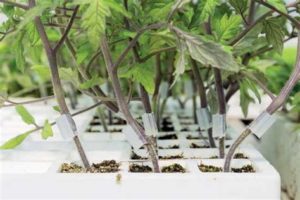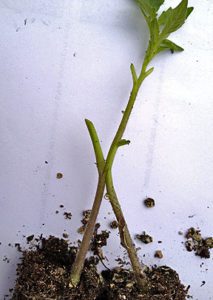Tomato grafting is a century-old technology that has its roots in the United States of America. However, it is slowly taking root across the world. In countries like China, Canada, and the UK, there is an increasing interest in grafted tomatoes. Having heard about the significant benefits of grafting tomatoes, especially for organic farmers, no one wants to be left behind.
When you graft tomato plants on wild tomato rootstock, you get an increase in resistance against soil-borne pathogens. You also get more resistance to water stress, pests, and nematodes. Commercial tomato varieties have been modified for yield, but they have done much less in disease resistance.
Let us get into the details of each of these:
Increased resistance to salt and water stress

Tomato plants need a regular supply of water to keep the soil around the roots moist. They not only need it for survival but also to grow tomatoes. Low water supply is known to cause salinity and acidity in the soil.
Grafting the rootstock of a plant that is known to have salt tolerance and grafting a high-yielding tomato plant on it will give you the best of both worlds. Wild tomatoes have shown salt tolerance and would be great rootstocks. One of the benefits of grafting tomatoes is that your tomato roots will survive the soil without being prevented from absorbing water and the top part will give you a high-quality yield.
Tomatoes grown in arid and semi-arid areas are at a high risk of suffering from salt stress. Salt stress is a result of high salt levels in the soil just like you might have high or low pH in the soil. High salinity makes it harder for tomato plants to absorb water through the roots. Arid and semi-arid soil tend to have high salinity in the soil and available water.

When your tomatoes can not absorb water they wilt. In advanced stages, your tomatoes may also have problems with photosynthesis, which is the process of plants making food. Although rare, extreme cases of salt stress may cause tomato plant death.
If you are growing tomatoes in a high salinity area, tomato varieties that are resistant to high salinity are a solution. When you graft right, your crop will not only survive the saltiness but also yield abundantly.
Read More: How To Start Grafting Multiple Tomatoes For Better Yields
Increased resistance to soil-borne diseases
Grafting tomatoes using rootstock known to be resistant to soil-borne pathogens offers extra protection for farmers. This is also one more of the benefits of grafting tomatoes. Although there are commercially available seeds that have disease-resistant traits, they are not full-proof. Farmers are still required to apply fungicides and bactericides along the way to keep these diseases at bay.
Soil-borne pathogens like those causing bacterial and Fusarium wilt, occur naturally in the soil and are known to cause major damage to farmers and their tomatoes. If you come from a region that is prone to bacterial wilt infections, then a rootstock from wild tomatoes can be a good choice. You can also consider laboratory-made rootstock which reduces the risk of reducing fruit size brought in by wild tomato rootstock. This has also been proven by some Kenyan researchers of its viability. In Dahachok-India, the perfect scion-rootstock combination is a Karma 444 grafted onto eggplant rootstock (KER-DC-117).
Increase resistance to soil-borne nematodes and pests
Tomato grafting for pest and nematode resistance has proven to be quite the challenge for researchers. Often, you find a resistant variety to nematodes that don’t have the same resistance in another geographical area. A few researchers tested Beaufort, Maxifort, and Big Power hybrid rootstocks, where they determined that Big Power is resistant to root-knot nematodes.
With the advent of resistant rootstocks, farmers have been able to produce vegetable crops in fields that were previously plagued with soil-borne plant diseases and plant-parasitic nematodes without having to use soil fumigants or nematicide treatments.
Continual refinement and development of new pest-resistant rootstocks will be required to ensure that grafting continues to be an even more successful means of managing pests and diseases on tomatoes as time progresses.
Limitation of growing grafted tomatoes
I know grafted tomatoes can seem like a from mother nature but it does come with it’s fair share of disadvantages. Like most new techniques, the knowledge and skill to implement it well is a huge setback.
Added cost
Obtaining grafted tomatoes will definitely set you back a significant amount of money. Unlike the regular seedlings you get from your vendor, grafted tomatoes take some more effort and resources to propagate and require some training and practice.
These added costs also come from issues like graft mismatches. You may have prepared grafts that do not pair up well and die soon after grafting. Or, they can give you very low yields.
Reduction in flower and fruit yield
Some of the rootstock used in tomato grafting may offer certain benefits like resistance to disease. However, some rootstocks that come from poor-yielding plants pass on those traits, of low yield, to the scion you graft onto it.
Summary
It is possible to boost the resilience of tomato plants to soil-borne diseases by grafting them onto wild tomato rootstocks. You’ll also have more tolerance to water stress, pests, and nematodes as a result of this treatment. Commercial tomato cultivars have been improved in terms of yield, but they have done considerably less so in terms of disease resistance, according to the USDA.





[…] in a smallholder farmer’s garden, boosting production is critical. Grafting multiple tomatoes improves the plant performance and dramatically increases your harvests per plant throughout the harvesting […]
[…] Read More: Can Tomato Grafting Make Your Tomatoes Stronger? […]
[…] Read More: Can Tomato Grafting Make Your Tomatoes Stronger? […]